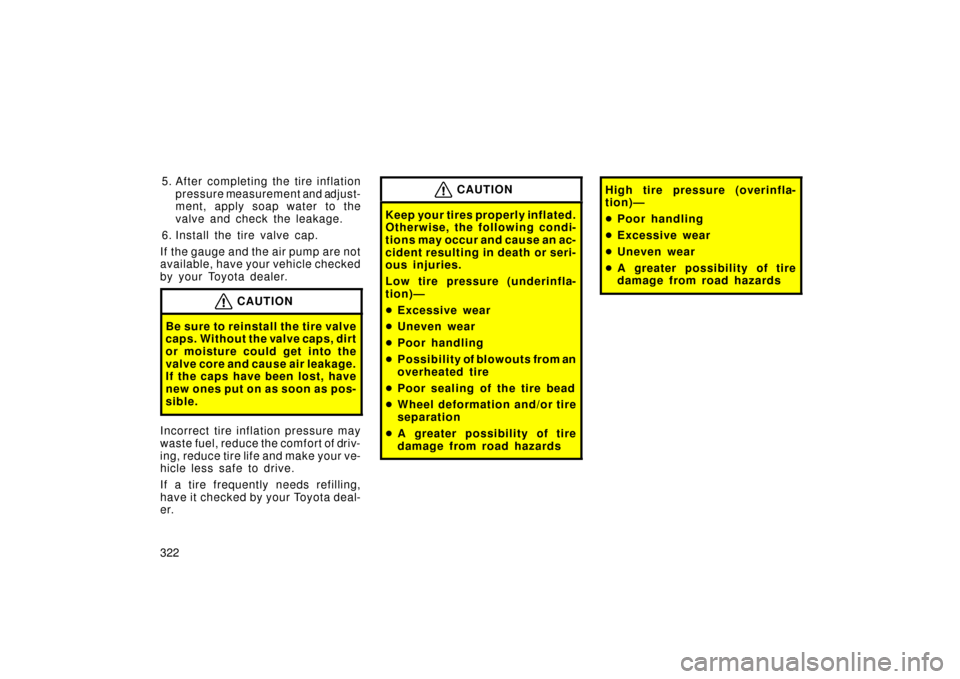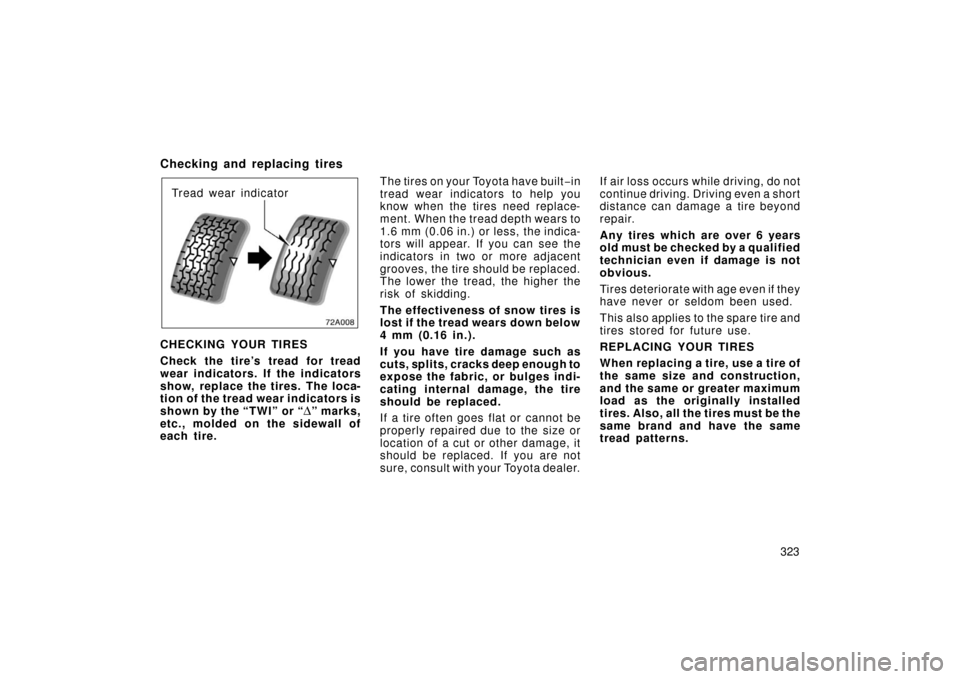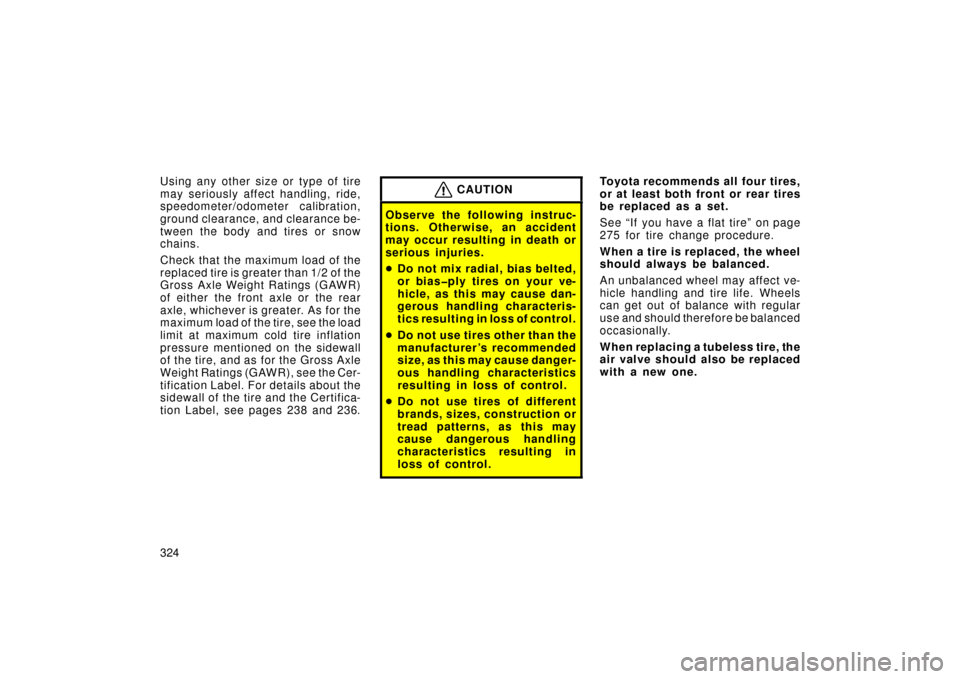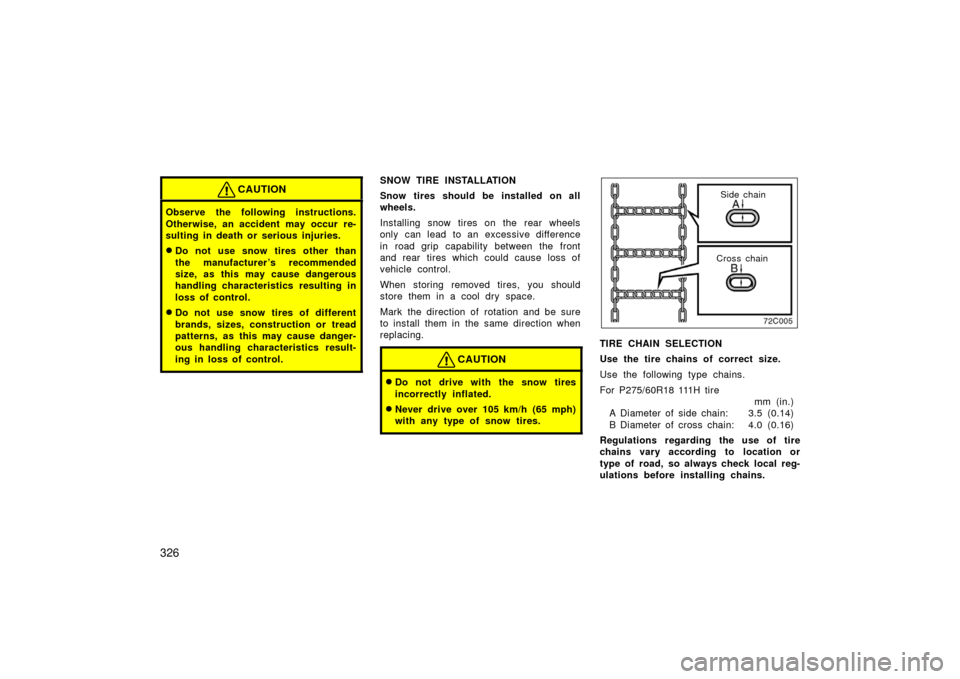Page 332 of 364

3225. After completing the tire inflation
pressure measurement and adjust-
ment, apply soap water to the
valve and check the leakage.
6. Install the tire valve cap.
If the gauge and the air pump are not
available, have your vehicle checked
by your Toyota dealer.
CAUTION
Be sure to reinstall the tire valve
caps. Without the valve caps, dirt
or moisture could get into the
valve core and cause air leakage.
If the caps have been lost, have
new ones put on as soon as pos-
sible.
Incorrect tire infl ation pressure may
waste fuel, reduce the comfort of driv-
ing, reduce tire life and make your ve-
hicle less safe to drive.
If a tire frequently needs refilling,
have it checked by your Toyota deal-
er.
CAUTION
Keep your tires properly inflated.
Otherwise, the following condi-
tions may occur and cause an ac-
cident resulting in death or seri-
ous injuries.
Low tire pressure ( underinfla-
tion)—
� Excessive wear
� Uneven wear
� Poor handling
� Possibility of blowouts from an
overheated tire
� Poor sealing of the tire bead
� Wheel deformation and/or tire
separation
� A greater possibility of tire
damage from road hazards
High tire pressure (overinfla-
tion)—
�Poor handling
� Excessive wear
� Uneven wear
� A greater possibility of tire
damage from road hazards
Page 333 of 364

323
Checking and replacing tires
Tread wear indicator
CHECKING YOUR TIRES
Check the tire’s tread for tread
wear indicators. If the indicators
show, replace the tires. The loca-
tion of the tread wear indicators is
shown by the “TWI” or “
Δ” marks,
etc., molded on the sidewall of
each tire. The tires on your Toyota have built
−in
tread wear indicators to help you
know when the tires need replace-
ment. When the tread depth wears to
1.6 mm (0.06 in.) or less, the indica-
tors will appear. If you can see the
indicators in two or more adjacent
grooves, the tire should be replaced.
The lower the tread, the higher the
risk of skidding.
The effectiveness of snow tires is
lost if the tread wears down below
4 mm (0.16 in.).
If you have tire damage such as
cuts, splits, cracks deep e nough to
expose the fabric, or bulges indi-
cating internal damage, the tire
should be repl aced.
If a tire often goes flat or cannot be
properly repaired due to the size or
location of a cut or other damage, it
should be replaced. If you are not
sure, consult with your Toyota dealer. If air loss occurs while driving, do not
continue driving. Driving even a short
distance can damage a tire beyond
repair.
An y ti res wh i ch are over 6 years
old must be checked by a qualified
technician even if damage is not
obvious.
Tires deteriorate with age even if they
have never or seldom been used.
This also applies to the spare tire and
tires stored for future use.
REPLACING YOUR TIRES
When replacing a tire, use a tire of
the same size and construction,
and the same or greater maximum
load as the originally installed
tires. Also, all the tires must be the
same brand and have the same
tread patterns.
Page 334 of 364

324 Using any other size or type of tire
may seriously affect handling, ride,
speedometer/odometer calibration,
ground clearance, and clearance be-
tween the body and tires or snow
chains.
Check that the maximum load of the
replaced tire is greater than 1/2 of the
Gross Axle Weight Ratings (GAWR)
of either the front axle or the rear
axle, whichever is greater. As for the
maximum load of the tire, see the load
limit at maximum cold tire inflation
pressure mentioned on the sidewall
of the tire, and as for the Gross Axle
Weight Ratings (GAWR), see the Cer-
tification Label. For details about the
sidewall of the tire and the Certifica-
tion Label, see pages 238 and 236.
CAUTION
Observe the following instruc-
tions. Otherwise, an accident
may occur resulting in death or
serious injuries.
�Do not mix radial, bias belted,
or bias�ply tires on your ve-
hicle, as this may cause dan-
gerous handling characteris-
tics resulting in loss of control.
� Do not use tires other than the
manufacturer’s recommended
size, as this may cause danger-
ous handling characteristics
resulting in loss of control.
� Do not use tires of different
brands, sizes, construction or
tread patterns, as this may
cause dangerous handling
characteristics resulting in
loss of control.
Toyota recommends all four tires,
or at least both front or rear tires
be replaced as a set.
See “If you have a flat tire” on page
275 for tire change procedure.
When a tire is replaced, the wheel
should always be balanced.
An unbalanced wheel may affect ve-
hicle handling and tire life. Wheels
can get out of balance with regular
use and should therefore be balanced
occasionally.
When replacing a tubeless tire, the
air valve should also be repl aced
w i t h a new on e.
Page 335 of 364

325
Rotating tires
To equalize tire wear and help ex-
tend tire life, Toyota recommends
that you rotate your tires accord-
ing to the maintenance schedule.
(For scheduled maintenance infor-
mation, please refer to the “Sched-
uled Maintenance Guide” or “Own-
er’s Manual Supplement”.)
However, the most appropriate tim-
ing for tire rotation may vary ac-
cording to your driving habits and
road surface conditions.See “If you have a flat tire” on page
275 for tire change procedure.
When rotating tires, check for uneven
wear and damage. Abnormal wear is
usually caused by incorrect tire infla-
tion pressure, improper wheel align-
ment, out
−of −balance wheels, or se-
vere braking.
WHEN TO USE SNOW TIRES OR
CHAINS
Snow tires or chains are recommended
when driving on snow or ice.
On wet or dry roads, conventional tires
provide better traction than snow tires.
SNOW TIRE SELECTION
If you need snow tires, select tires of
the same size, construction and load
capacity as the originally installed tires.
Also, all the tires must be the same
brand and have the same tread pat-
terns.
Do not use tires other than those men-
tioned above. Do not install studded tires
without first checking local regulations for
possible restrictions.
Installing snow tires and
chains
Page 336 of 364

326
CAUTION
Observe the following instructions.
Otherwise, an accident may occur re-
sulting in death or serious injuries.
�Do not use snow tires other than
the manufacturer ’s recommended
size, as this may cause dangerous
handling characteristics resulting in
loss of control.
�Do not use snow tires of different
brands, sizes, construction or tread
patterns, as this may cause danger-
ous handling characteristics result-
ing in loss of control.
SNOW TIRE INSTALLATION
Snow tires should be installed on all
wheels.
Installing snow tires on the rear wheels
only can lead to an excessive difference
in road grip capability between the front
and rear tires which could cause loss of
vehicle control.
When storing removed tires, you should
store them in a cool dry space.
Mark the direction of rotation and be sure
to install them in the same direction when
replacing.
CAUTION
�Do not drive with the snow tires
incorrectly inflated.
�Never drive over 105 km/h (65 mph)
with any type of snow tires.
Cross chainSide chain
TIRE CHAIN SELECTION
Use the tire chains of correct size.
Use the following type chains.
For P275/60R18 111H tire
mm (in.)
A Diameter of side chain: 3.5 (0.14)
B Diameter of cross chain: 4.0 (0.16)
Regulations regarding the use of tire
chains vary according to location or
type of road, so always check local reg-
ulations before installing chains.
Page 354 of 364
344
Tires
Tire size and inflation pressure:kPa (psi)
Ti r e siz e
FrontRearWheel sizeNormal drivingTr ailer towingNormal drivingTr ailer towing
P275/60R18 111H200 (29)220 (32)220 (32)240 (35)18 � 8JJ
Wheel nut torque, N·m (kgf·m, ft·lbf): 131 (13.4, 96.6)
NOTE: For a complete information on tires (e.g. replacing tires or replacing wheels), see “Checking tire inflation pressure” on page 320 through “Aluminum wheel precautions” on page 328.
Page 361 of 364

Publication No. OM60B63U
Part No. 01999-60B63
Printed in Japan 01−0505 −00
Quick index
� If a service reminder indicator or warning buzzer comes on 124
. . . .
� If your vehicle will not start 270 . . . . . . . . . . . . . . . . . . . . . . . . . . . . . . . . . . .
� If your engine stalls while driving 274 . . . . . . . . . . . . . . . . . . . . . . . . . . . . . .
� If your vehicle overheats 274 . . . . . . . . . . . . . . . . . . . . . . . . . . . . . . . . . . . . .\
.
� If you have a flat tire 275 . . . . . . . . . . . . . . . . . . . . . . . . . . . . . . . . . . . . .\
. . . .
� If your vehicle needs to be towed 287 . . . . . . . . . . . . . . . . . . . . . . . . . . . . .
� Tips for driving during break-in period 225 . . . . . . . . . . . . . . . . . . . . . . . . . .
� How to start the engine 252 . . . . . . . . . . . . . . . . . . . . . . . . . . . . . . . . . . . . .\
. .
� General maintenance 303 . . . . . . . . . . . . . . . . . . . . . . . . . . . . . . . . . . . . .\
. . . . .
Gas station information
Fuel type:
UNLEADED gasoline, Octane Rating 87 (Research Octane Number 91)
or higher. For improved vehicle performance, the use of premium unleaded
gasoline with an Octane Rating of 91 (Research Octane Number 96) or
higher is recommended.
See page 225 for detailed information.
Fuel tank capacity: 96 L (25.4 gal., 21.1 lmp.gal.)
Engine oil:
API grade, SL “Energy −Conserving” or ILSAC multigrade engine oil
is recommended.
See page 315 for detailed information.
Tire information: See pages 320 through 328.
Tire inflation pressure: See page 344.
U�5
I